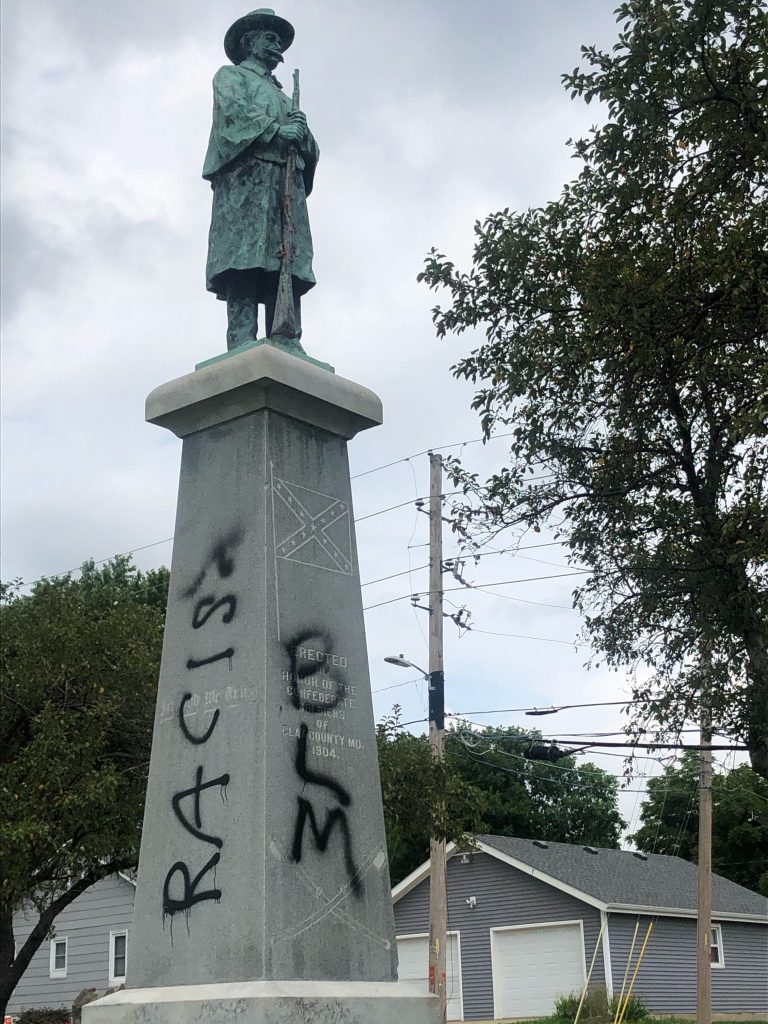
Erected in 1904, a monument of a nondescript Confederate soldier stands in the Fairview and New Hope Cemeteries in Liberty, Mo. Situated on an obelisk and etched onto the monument is a dedication to the memory of the Daughters of the Confederacy of Clay County.
The obelisk features several etchings – including the Confederate Battle Flag and a section honoring the Confederate soldiers of Clay County. The monument resides close to a portion of the cemetery where African Americans were historically buried.
An element of the greater controversy, both in Liberty and nationally, has been over the purpose and meaning of these statues. Whether these monuments are solely Confederate monuments, or if they serve as grave markers for war dead. In the case of the Fairview monument, supporters of removal say it is the former.
“Some of the people who do not want it removed call it a grave marker, but it’s actually just a monument, a memorial, there are no persons named on there that are buried in that area at all,” explained Dr. Judith Dilts, a local resident active in the movement and former Jewell professor of biology.
Liberty’s monument is entwined both in its past and in its future to the national history and discussion regarding the Confederate monuments.
For years, there has been a long-running national debate about monuments and statues dedicated to the Confederacy or figures tied to the Confederacy. Fierce arguments occur throughout the country as Americans have struggled to come to terms with what these monuments mean. Proponents of removal generally argue that the monuments represent a celebration of slavery, which was a cornerstone of the Confederacy. Opponents argue that to remove them would amount to an erasure of American history.
Debates have emerged about the future of Confederate monuments across Missouri as well, including at the Confederate Memorial State Historic Site in Higginsville, Mo. – where the state recently held an informational meeting to receive feedback from residents.
Liberty’s debate about the Confederate monument offers a microcosm of this national debate.
The Fairview monument’s construction in 1904, decades after the Civil War, is not an unusual origin for these statues. Historians generally chart the construction of Confederate monuments to two primary surges in the twentieth century.
First, in the early twentieth century, during the proliferation of the Jim Crow era that disenfranchised Black people, there was a surge in erecting monuments to the Confederacy spearheaded by the United Daughters of the Confederacy. It was during this period that the Fairview monument was constructed.
Supporters of the contemporary movement to remove the statue cite this history.
“The purpose of it was to promote the ‘Lost Cause’ of why we had a Civil War. Not because we enslaved people but because of states’ rights or economic reasons,” said Dilts.
Next, during the 1920s through the 1940s as Civil Rights agitation grew, White Southerners responded with another wave of Confederate monument construction.
This history has led many historians to note that, given the history of the construction, the purpose of most of the monuments was to further entrench white supremacy and not to honor war dead.
In Liberty, a movement to remove the monument built momentum over the summer, in the wake of the killing of George Floyd. Numerous petitions were started that called for the monument’s removal, and groups of citizens began to organize around the goal of having the monument removed.
One of the most prominent groups in opposition of the monument, Clay Countians for Inclusion, has emphasized contextualizing the monument within history. This organization notes that the monument has etched onto it a direct reference to Confederate General Nathan Bedford Forrest. Forrest, infamous for killing three hundred surrendered, mostly African American Union soldiers, during the Fort Pillow Massacre, subsequently became the first grand wizard of the Klu Klux Klan.
Those active in the movement, like Dilts, see raising public awareness in Liberty about the monument and its history as a key goal. The ultimate decision is going to be made by the City Council, so Clay Countians for Inclusion and others have been active in attending City Council meetings. During these meetings, a period of time is devoted to hearing from local residents. Since August, people have attended meetings to weigh in on the monument and its potential removal.
“Because it honors white supremacy, it honors enslavement. It represents values that we as citizens of Liberty don’t want to aspire to. I’d always play in my head: life, liberty, and the pursuit of happiness and we don’t have liberty and justice for all in Liberty as long as that monument stands,” Dr. Dilts said, when asked why she personally believes the monument should be removed.
“Removal is going to be up to the City Council. People can contact their City Council representatives, they can go to the Council meetings and speak during Citizens’ participation. They can write letters, make phone calls, send text messages to the mayor, to the City Council, and the City Administration supporting the removal of the statue and monument from the Fairview cemetery. They can also solicit the support of their associates and others within their inner circle or sphere of influence to let their voice be heard about the recommendations about the removal of the monument,” Dr. Dilts explained, when asked about how others could help.
Presently, the Liberty City Council has not made a final determination on the future of the monument. On Nov. 9 the City Council will hold a general meeting.
